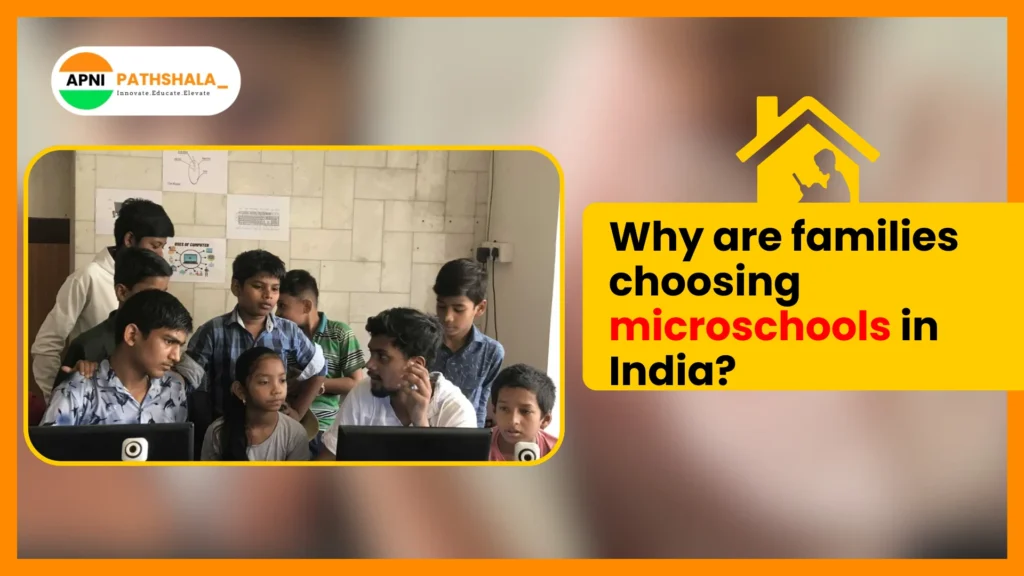Why are families choosing microschools in India?

Every evening, thousands of parents across India ask the same question: “How was school today?” And most kids? They say, “It was fine.” No excitement. No curiosity. Just boredom. If you’ve ever felt like your child isn’t really learning, just memorizing, you’re not alone. A quiet shift is happening. More families across India are questioning the old schooling system. And many are choosing something different. Something better. They’re choosing microschools. Let’s explore why. What is a microschool? A micro school is like a small classroom with a big heart. It usually has 5–15 children. The learning is personalized. The pace is flexible. And the focus is not just on marks, but on real growth. Microschools can be run by parents, teachers, or even communities. They often happen at home or in shared learning spaces. Some follow a specific curriculum (like NIOS), while others create their own mix. Think of it like this: A school that fits your child, not the other way around. Why are Indian families choosing microschools? 1. Children Deserve Personal Attention Let’s be honest, how much personal attention can one teacher give in a class of 40+ students? Even with the best intentions, kids fall through the cracks. Some stay quiet because they’re shy. Others lose interest because they’re bored. And a few are always trying to “catch up.” Microschools change this. With only 5–15 kids in a learning group, facilitators (not traditional teachers) actually know each child: Here, no one gets left behind. Kids are free to ask questions, take time to explore topics, and grow at their own pace. This is called personalized learning and it’s one of the biggest reasons parents choose microschools. 2. Flexible Learning, No Pressure In most schools, kids have to: That’s not how real learning works. Microschools offer flexibility that fits the child, not the other way around. If your child is more active in the morning or prefers to learn through hands-on experiments, they can. Here’s how flexibility shows up: Every child has a different learning style: visual, auditory, reading/writing, or kinesthetic. Microschools let them discover what works best. That means fewer meltdowns, more motivation, and deeper learning. 3. Education That Feels Real Let’s face it, how often do school lessons feel connected to real life? How many of us used trigonometry while filing our taxes or found Shakespeare helpful in job interviews? Microschools focus on learning that’s useful, meaningful, and grounded in real life. Here, your child: They don’t just memorize facts, they understand why they matter. This is future-ready education, something that’s deeply missing in traditional setups. You’ll hear terms like project-based learning and experiential learning in microschool communities. But really, it just means learning by doing. 4. Kids Feel Safe, Heard, and Happy A child learns best when they feel: In large schools, bullying, comparison, and competition can cause stress. Even good kids start to shut down emotionally. Microschools are built to be safe learning environments. With fewer students, trust grows faster. Children become part of a small community where: And guess what? When kids feel emotionally safe, their brain works better. That’s backed by science. Happy kids = Better learning outcomes. 5. Parents Become Partners in Learning Most schools expect parents to just pay fees and show up for PTMs. But what if you were part of your child’s actual learning journey? In microschools, parents are partners, not outsiders. You can: This creates a deep connection between home and school. You know exactly what your child is learning, how they’re growing, and where they need help. It’s not a “school” you send your child to. It’s a learning community you belong to. Real Learning > Rote Learning In traditional schools, success = good grades. In microschools, success = curious, confident, kind humans. Parents are waking up to the truth: education isn’t about marks, it’s about mindset. Microschools offer an environment where: Whether your child loves robots, animals, stories, or science, they get the freedom to follow their curiosity and the guidance to go deep. It’s Also About Mental Health Here’s something we don’t talk about enough: kids are anxious. Academic pressure, bullying, lack of sleep, screen addiction, it’s real. And it’s hurting our children. Microschools are designed with mental health in mind: It’s not just about learning more. It’s about learning better and living better. Microschools Are Growing in India This is not just an idea from the West. Microschools in India are growing fast. Cities like Bengaluru, Pune, Mumbai, Ahmedabad, Jaipur, and even smaller towns now have microschool communities. And why not? Indian families are realizing that the old system isn’t working. NEP 2020 encourages foundational literacy, critical thinking, and flexible learning, everything microschools already practice. Many Indian parents who tried homeschooling during the pandemic have now shifted to microschools for: How Do Microschools Work in India? Every microschool is different. But here’s a general idea: Microschools blend the best of structure and freedom. Is a microschool right for your family? Ask yourself: If yes, a microschool might be what you’re looking for. You don’t need to jump into it overnight. Start slow. Explore. Talk to other parents. How does ApniPathshala help you start your microschool journey? At Apni Pathshala, we support parents and educators who want to: We offer resources, training, and real stories of families just like yours. Ready to take the first step? Contact ApniPathshala to explore how we can help you build a better learning path for your child. You don’t have to do it alone.
